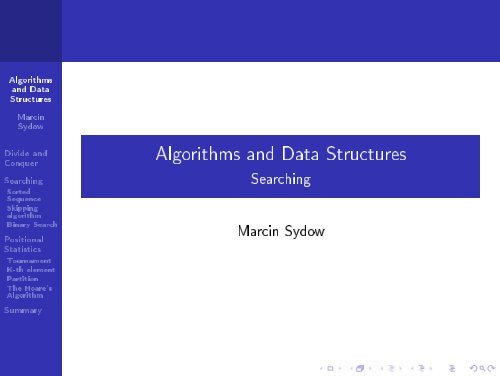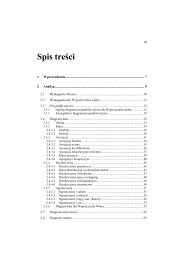Algorithms and Data Structures - Searching - pjwstk
Algorithms and Data Structures - Searching - pjwstk
Algorithms and Data Structures - Searching - pjwstk
You also want an ePaper? Increase the reach of your titles
YUMPU automatically turns print PDFs into web optimized ePapers that Google loves.
<strong>Algorithms</strong><strong>and</strong> <strong>Data</strong><strong>Structures</strong>MarcinSydowDivide <strong>and</strong>Conquer<strong>Searching</strong>SortedSequenceSkippingalgorithmBinary SearchPositionalStatisticsTournamentK-th elementPartitionThe Hoare'sAlgorithmSummary<strong>Algorithms</strong> <strong>and</strong> <strong>Data</strong> <strong>Structures</strong><strong>Searching</strong>Marcin Sydow
Topics covered by this lecture:<strong>Algorithms</strong><strong>and</strong> <strong>Data</strong><strong>Structures</strong>MarcinSydowDivide <strong>and</strong>Conquer<strong>Searching</strong>SortedSequenceSkippingalgorithmBinary SearchPositionalStatisticsTournamentK-th elementPartitionThe Hoare'sAlgorithmSummaryDivide <strong>and</strong> Conquer Rule<strong>Searching</strong>Binary Search AlgorithmPositional StatisticsThe second smallest element (The Tournament algorithm- idea)Hoare's Algorithm (idea)
Divide <strong>and</strong> Conquer<strong>Algorithms</strong><strong>and</strong> <strong>Data</strong><strong>Structures</strong>MarcinSydowDivide <strong>and</strong>Conquer<strong>Searching</strong>SortedSequenceSkippingalgorithmBinary SearchPositionalStatisticsTournamentK-th elementPartitionThe Hoare'sAlgorithmSummaryOne of the most important methods for algorithm design.Divide the problem into a couple of smaller sub-problems suchthat it is easy to reconstruct the solution from the sub-solutionsIt is quite often implemented as a recursion - a programmingtechnique in which a function calls itself (for a sub-problem)Divide <strong>and</strong> Conquer has origins in politics, <strong>and</strong> its name (originaly inLatin: Divide et Impera) is traditionally assigned to Philip II, the king ofMacedonia (382-336 BC) in the context of his rules over Greeks (source:Wikipedia)
The <strong>Searching</strong> Problem<strong>Algorithms</strong><strong>and</strong> <strong>Data</strong><strong>Structures</strong>MarcinSydowDivide <strong>and</strong>Conquer<strong>Searching</strong>SortedSequenceSkippingalgorithmBinary SearchPositionalStatisticsTournamentK-th elementPartitionThe Hoare'sAlgorithmSummarysearch(S, len, key)Input: S - a sequence of integers (indexed from 0 to len-1); len- length of the sequence; key - integer number (to be found)Output: index - a natural number less than len, meaning (any)index in the sequence S under which the key is present (i.e.S[index]==key) or -1 if the key is not present in the sequenceE.g. for S = (3,5,8,2,1,8,4,2,9), <strong>and</strong> the above specication,search should behave as follows:search(S, 9, 2) stops <strong>and</strong> returns: 3search(S, 9, 7) stops <strong>and</strong> returns: -1
<strong>Searching</strong>, cont.<strong>Algorithms</strong><strong>and</strong> <strong>Data</strong><strong>Structures</strong>MarcinSydowDivide <strong>and</strong>Conquer<strong>Searching</strong>SortedSequenceSkippingalgorithmBinary SearchPositionalStatisticsTournamentK-th elementPartitionThe Hoare'sAlgorithmSummaryA natural c<strong>and</strong>idate for dominating operation in st<strong>and</strong>ardalgorithms solving the searching problem is comparisonoperation <strong>and</strong> the data size is usually the length of thesequence (len)One can apply the sequential search algorithm to solve thisproblem (it was discussed on the previous lectures). It haslinear time complexity W (len) = Θ(len). The multiplicativefactor is 1 (W(len) = len). <strong>and</strong> it cannot be improved, becauseof the specicity of the problem.
More Eective <strong>Searching</strong>?<strong>Algorithms</strong><strong>and</strong> <strong>Data</strong><strong>Structures</strong>MarcinSydowDivide <strong>and</strong>Conquer<strong>Searching</strong>SortedSequenceSkippingalgorithmBinary SearchPositionalStatisticsTournamentK-th elementPartitionThe Hoare'sAlgorithmSummaryWhat additional property of the input sequence would help tosearch more eciently?
More Eective <strong>Searching</strong>?<strong>Algorithms</strong><strong>and</strong> <strong>Data</strong><strong>Structures</strong>MarcinSydowDivide <strong>and</strong>Conquer<strong>Searching</strong>SortedSequenceSkippingalgorithmBinary SearchPositionalStatisticsTournamentK-th elementPartitionThe Hoare'sAlgorithmSummaryWhat additional property of the input sequence would help tosearch more eciently?Sorting the input sequence
<strong>Searching</strong> in Sorted Sequence<strong>Algorithms</strong><strong>and</strong> <strong>Data</strong><strong>Structures</strong>MarcinSydowDivide <strong>and</strong>Conquer<strong>Searching</strong>SortedSequenceSkippingalgorithmBinary SearchPositionalStatisticsTournamentK-th elementPartitionThe Hoare'sAlgorithmSummaryIt is a dierent problem (because of a dierent specication -the input condition is dierent)Input: S - a sequence of non-decreasingly sorted 1 integers(indexed from 0 to len-1); len - a natural number - length of thesequence; key - integer numberOutput: index - a natural number less than len meaning (any)index in the sequence S such that S[index]==key or -1 if key isnot present in S.With such an additional assumption on the input data it ispossible to solve the problem more eciently (faster) thanpreviously1 if the sequence is non-increasingly sorted it also helps (in similar way) -but this would be even another problem specication
Skipping Algorithm<strong>Algorithms</strong><strong>and</strong> <strong>Data</strong><strong>Structures</strong>MarcinSydowDivide <strong>and</strong>Conquer<strong>Searching</strong>SortedSequenceSkippingalgorithmBinary SearchPositionalStatisticsTournamentK-th elementPartitionThe Hoare'sAlgorithmSummaryIf input sequence is sorted it is possible to check each k-th cell(skipping k-1 elements on each jump) <strong>and</strong>, in case of ndingthe rst number which is higher than the key, check only thelast k-1 elements (or if the sequence ended return -1)Notice that such an algorithm is asymptotically (i.e. forlen → ∞) k times faster (on average) than normal sequentialsearch 2 (for unordered input sequence): W (len) = 1 k · Θ(len),but is is still linear - thus the rank of complexity was notimproved with this version of the algorithmIs it possible to improve the complexity rank of searching forsorted input sequence?2 it is possible to prove that the optimal choice for k, in terms ofpessimistic complexity, is k = √ len
Divide <strong>and</strong> Conquer <strong>and</strong> <strong>Searching</strong><strong>Algorithms</strong><strong>and</strong> <strong>Data</strong><strong>Structures</strong>MarcinSydowDivide <strong>and</strong>Conquer<strong>Searching</strong>SortedSequenceSkippingalgorithmBinary SearchPositionalStatisticsTournamentK-th elementPartitionThe Hoare'sAlgorithmSummarysearch(S, len, key)(input sequence is sorted)The Binary Search Algorithm (the Divide <strong>and</strong> Conquerapproach)1 while the length of sequence is positive:2 check the middle element of the current sequence3 if it is equal to key - return the result4 if it is higher than key - restrict searching to the leftsub-sequence (from the current position)5 if it is less than key - restrict searching to the rightsub-sequence (from the current position)6 back to the point 17 there is no key in the sequence (if you are here)
Binary Search Algorithm<strong>Algorithms</strong><strong>and</strong> <strong>Data</strong><strong>Structures</strong>MarcinSydowDivide <strong>and</strong>Conquer<strong>Searching</strong>SortedSequenceSkippingalgorithmBinary SearchPositionalStatisticsTournamentK-th elementPartitionThe Hoare'sAlgorithmSummarysearch(S, len, key){l = 0r = len - 1while(l key) r = m - 1else l = m + 1}return -1}Notice that the operation of r<strong>and</strong>om access (direct access) tothe m-th element S[m] of the sequence dem<strong>and</strong>s that thesequence is kept in RAM (to make the operation ecient)
Analysis of the Binary Search Algorithm<strong>Algorithms</strong><strong>and</strong> <strong>Data</strong><strong>Structures</strong>MarcinSydowDivide <strong>and</strong>Conquer<strong>Searching</strong>SortedSequenceSkippingalgorithmBinary SearchPositionalStatisticsTournamentK-th elementPartitionThe Hoare'sAlgorithmSummary<strong>Data</strong> size: length of the sequence - lenDominating operation: comparison - (S[m] == key)(assume the sequence is kept in RAM)With each iteration the sequence becomes 2 times shorter. Thealgorithm stops when the length of sequence becomes 1W (len) = Θ(log 2 (len))A(len) = Θ(log 2 (len))S(len) = O(1)(Notice: the assumption about data in RAM is important)Observation: if data is sorted but it does not t into RAM,this analysis is inadequate (because comparison S[m] == keycannot be considered as an atomic operation)
Positional Statistics<strong>Algorithms</strong><strong>and</strong> <strong>Data</strong><strong>Structures</strong>MarcinSydowDivide <strong>and</strong>Conquer<strong>Searching</strong>SortedSequenceSkippingalgorithmBinary SearchPositionalStatisticsTournamentK-th elementPartitionThe Hoare'sAlgorithmSummaryThe k-th positional statistic in a sequence of elements (whichcan be ordered) is the k-th smallest (largest) element in thesequenceE.g. the task of nding minimum is nothing dierent thansearching the 1-st positional statistic in this sequenceIn the case of sorted sequence this task is trivial - k-th statisticis just the k-th element in the sequence.
<strong>Searching</strong> the 2nd Smallest Element in Sequence<strong>Algorithms</strong><strong>and</strong> <strong>Data</strong><strong>Structures</strong>MarcinSydowDivide <strong>and</strong>Conquer<strong>Searching</strong>SortedSequenceSkippingalgorithmBinary SearchPositionalStatisticsTournamentK-th elementPartitionThe Hoare'sAlgorithmSummarysecond(S, len)(no assumption that the sequence is sorted)Input: S - sequence of elements that can be ordered (e.g.integers, symbols of alphabet, etc.); len - the length ofsequenceOutput: the second smallest element s of the sequence S<strong>Data</strong> size, for algorithm solving this problem, is usually thelength of sequence <strong>and</strong> the dominating operation (usually)comparison.A simple solution: nd minimum, exclude it from the sequence,<strong>and</strong> repeat this (needs 2 · len comparisons).
<strong>Searching</strong> the 2nd Smallest Element in Sequence<strong>Algorithms</strong><strong>and</strong> <strong>Data</strong><strong>Structures</strong>MarcinSydowDivide <strong>and</strong>Conquer<strong>Searching</strong>SortedSequenceSkippingalgorithmBinary SearchPositionalStatisticsTournamentK-th elementPartitionThe Hoare'sAlgorithmSummarysecond(S, len)(no assumption that the sequence is sorted)Input: S - sequence of elements that can be ordered (e.g.integers, symbols of alphabet, etc.); len - the length ofsequenceOutput: the second smallest element s of the sequence S<strong>Data</strong> size, for algorithm solving this problem, is usually thelength of sequence <strong>and</strong> the dominating operation (usually)comparison.A simple solution: nd minimum, exclude it from the sequence,<strong>and</strong> repeat this (needs 2 · len comparisons).Can it be done more eectively?
The Tournament Algorithm - idea<strong>Algorithms</strong><strong>and</strong> <strong>Data</strong><strong>Structures</strong>MarcinSydowDivide <strong>and</strong>Conquer<strong>Searching</strong>SortedSequenceSkippingalgorithmBinary SearchPositionalStatisticsTournamentK-th elementPartitionThe Hoare'sAlgorithmSummaryLet's apply the divide <strong>and</strong> conquer method:Imagine a tournament proceeding in turns.In each turn the sequence is divided into pairs. Both elementsin each pair compete with each other - the winner is thesmaller one. Only the winners from the current turn survive tothe next turn.We stop when the sequence consist of only 1 element - this isthe smallest element in the original sequence.But where in the tournament history is the second smallest?
The Tournament Algorithm - idea<strong>Algorithms</strong><strong>and</strong> <strong>Data</strong><strong>Structures</strong>MarcinSydowDivide <strong>and</strong>Conquer<strong>Searching</strong>SortedSequenceSkippingalgorithmBinary SearchPositionalStatisticsTournamentK-th elementPartitionThe Hoare'sAlgorithmSummaryLet's apply the divide <strong>and</strong> conquer method:Imagine a tournament proceeding in turns.In each turn the sequence is divided into pairs. Both elementsin each pair compete with each other - the winner is thesmaller one. Only the winners from the current turn survive tothe next turn.We stop when the sequence consist of only 1 element - this isthe smallest element in the original sequence.But where in the tournament history is the second smallest?Among the direct competitors of the winner - the secondsmallest could lose only with the smallest.
Analysis of the Tournament Algorith<strong>Algorithms</strong><strong>and</strong> <strong>Data</strong><strong>Structures</strong>MarcinSydowDivide <strong>and</strong>Conquer<strong>Searching</strong>SortedSequenceSkippingalgorithmBinary SearchPositionalStatisticsTournamentK-th elementPartitionThe Hoare'sAlgorithmSummaryThe tournament could be naturally represented as a tree, wherethe lowest level (the leaves) is the original sequence <strong>and</strong> theroot is the winner. The number of levels is O(log 2 (len))<strong>Data</strong> size: length of the original sequence - lenDominating operation: comparison between 2 elementsAll the comparisons in the tournament need exactly len-1comparison operations (why?)In the nal phase (seeking for the second smallest) the wholepath from the leaf (the rst competitor of the subsequentwinner) to the root is scanned for the minimum - accounting foranother O(log 2 (len)) comparisons (explained later)Thus, this algorithm has lower complexity than repeatedminimum, but the same rank (linear)
K-th positional statistics - the Hoare's Algorithm(idea)<strong>Algorithms</strong><strong>and</strong> <strong>Data</strong><strong>Structures</strong>MarcinSydowDivide <strong>and</strong>Conquer<strong>Searching</strong>SortedSequenceSkippingalgorithmBinary SearchPositionalStatisticsTournamentK-th elementPartitionThe Hoare'sAlgorithmSummarykthSmallest(S, len, k)(no assumption of order of the input sequence)Input: S - sequence of elements that can be ordered (e.g.integers, alphabet symbols, etc.); len - the length of thesequence; k - positive natural number (which positionalstatistic are we searching for?)Output: the element s in the sequence S, being the k-thsmallest elementAs previously, it is possible to repeat k times the minimumsearch (excluding the minimum each time) - it needs to linearlyscan the sequence k times. However, the task can be solvedmuch more eciently with application of the divide <strong>and</strong>conquer method.
The Partition Procedure<strong>Algorithms</strong><strong>and</strong> <strong>Data</strong><strong>Structures</strong>MarcinSydowDivide <strong>and</strong>Conquer<strong>Searching</strong>SortedSequenceSkippingalgorithmBinary SearchPositionalStatisticsTournamentK-th elementPartitionThe Hoare'sAlgorithmSummarypartition(S, l, r)input: S - sequence of elements that can be ordered; l - the left(starting) index of the subsequence to be processed; r - theright (ending) indexoutput: i - the nal position of the median element M (seebelow in the description)For a given sequence S the partition procedure eectivelyselects some element M <strong>and</strong> re-organises the sequence S suchthat all the elements on the left of M are not greater than M<strong>and</strong> all the elements on the right of M are not less than M. Theprocedure nally returns the index i of the element M.
Analysis of Partition<strong>Algorithms</strong><strong>and</strong> <strong>Data</strong><strong>Structures</strong>MarcinSydowDivide <strong>and</strong>Conquer<strong>Searching</strong>SortedSequenceSkippingalgorithmBinary SearchPositionalStatisticsTournamentK-th elementPartitionThe Hoare'sAlgorithmSummaryNotice the following property: if the index returned by partitionequals k the element under this index (M) is the k-th positionalstatistic in S (due to the partition formulation) (assumeindexing from 1).For the following assumptions:Dominating operation: comparing 2 elements<strong>Data</strong> size: length of the sequence n = (r − l + 1)The partition procedure can be designed such that itscomplexity W (n) = n + O(1) <strong>and</strong> S(n) = O(1)
The above algorithm (together with the partition procedure)was invented by J.R.Hoare.The Hoare's Algorithm - idea<strong>Algorithms</strong><strong>and</strong> <strong>Data</strong><strong>Structures</strong>MarcinSydowDivide <strong>and</strong>Conquer<strong>Searching</strong>SortedSequenceSkippingalgorithmBinary SearchPositionalStatisticsTournamentK-th elementPartitionThe Hoare'sAlgorithmSummaryThe partition procedure <strong>and</strong> the divide <strong>and</strong> conquermethod can be applied to design a very ecient algorithm forsearching the k-th positional statistics, as follows:call partition on the sequenceif the returned index is equal to k - return S[k]else, depending on the value returned by the partition,continue (from point 1) on the left or rightsub-sequence from M (take into account the number ofab<strong>and</strong>oned elements to the left)The time complexity of the above algorithm is linear(independently on k) <strong>and</strong>, on average, it is much faster thanthe repeated minimum algorithm. More detailed discussion ofthis algorithm will be given later (with quickSort).
Questions/Problems:<strong>Algorithms</strong><strong>and</strong> <strong>Data</strong><strong>Structures</strong>MarcinSydowDivide <strong>and</strong>Conquer<strong>Searching</strong>SortedSequenceSkippingalgorithmBinary SearchPositionalStatisticsTournamentK-th elementPartitionThe Hoare'sAlgorithmSummaryThe problem of searching (sequential algorithm)<strong>Searching</strong> in a sorted sequence (skipping k elements)Binary Search Algorithm (analysis + code)Positional StatisticsThe Tournament AlgorithmThe Partition Procedure (only the specication)The Hoare's Algorithm (only the idea)
<strong>Algorithms</strong><strong>and</strong> <strong>Data</strong><strong>Structures</strong>MarcinSydowDivide <strong>and</strong>Conquer<strong>Searching</strong>SortedSequenceSkippingalgorithmBinary SearchPositionalStatisticsTournamentK-th elementPartitionThe Hoare'sAlgorithmSummaryThank you for your attention







![MAS-02-en [tryb zgodnoÅci] - pjwstk](https://img.yumpu.com/49308962/1/190x143/mas-02-en-tryb-zgodnoaci-pjwstk.jpg?quality=85)








